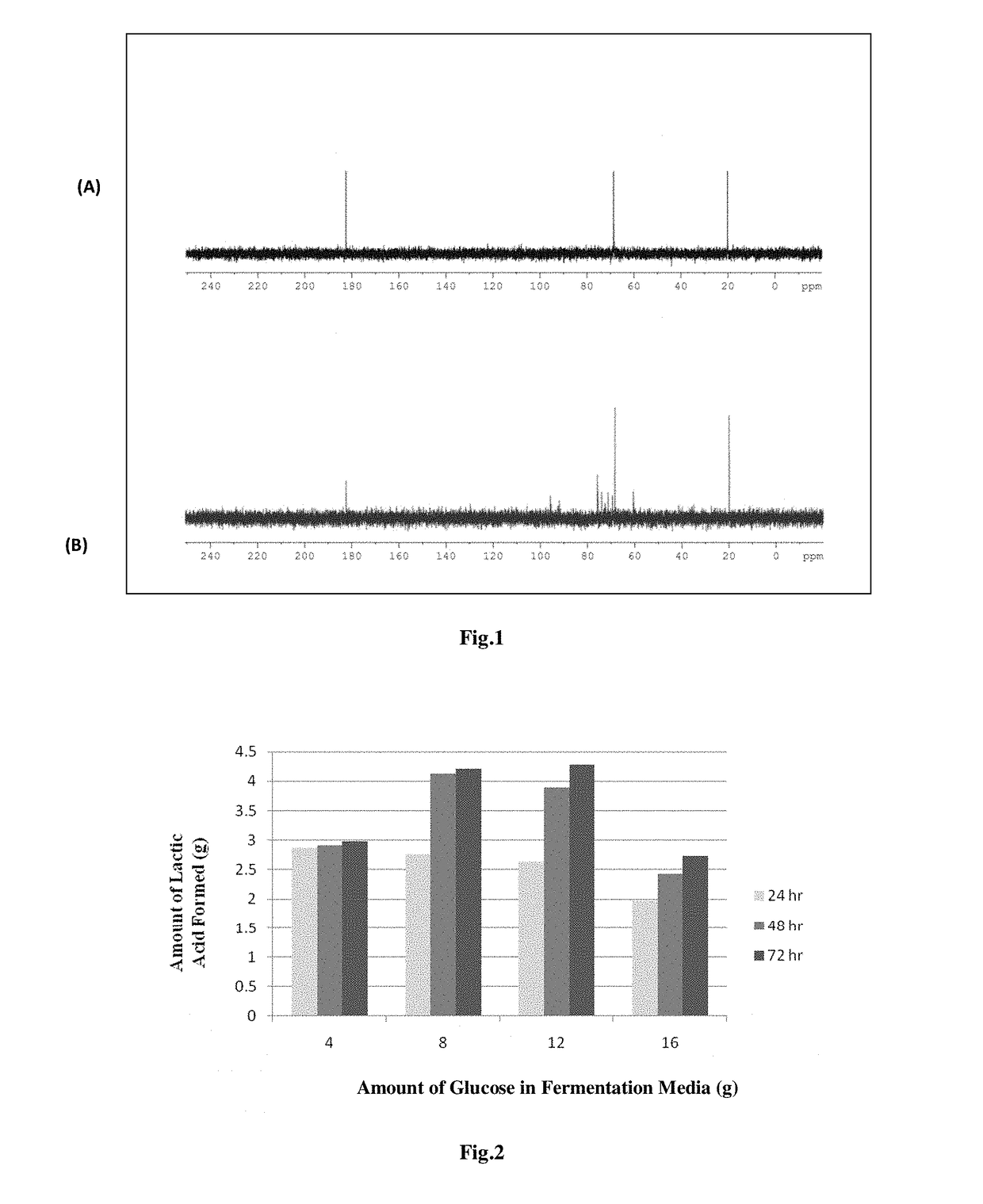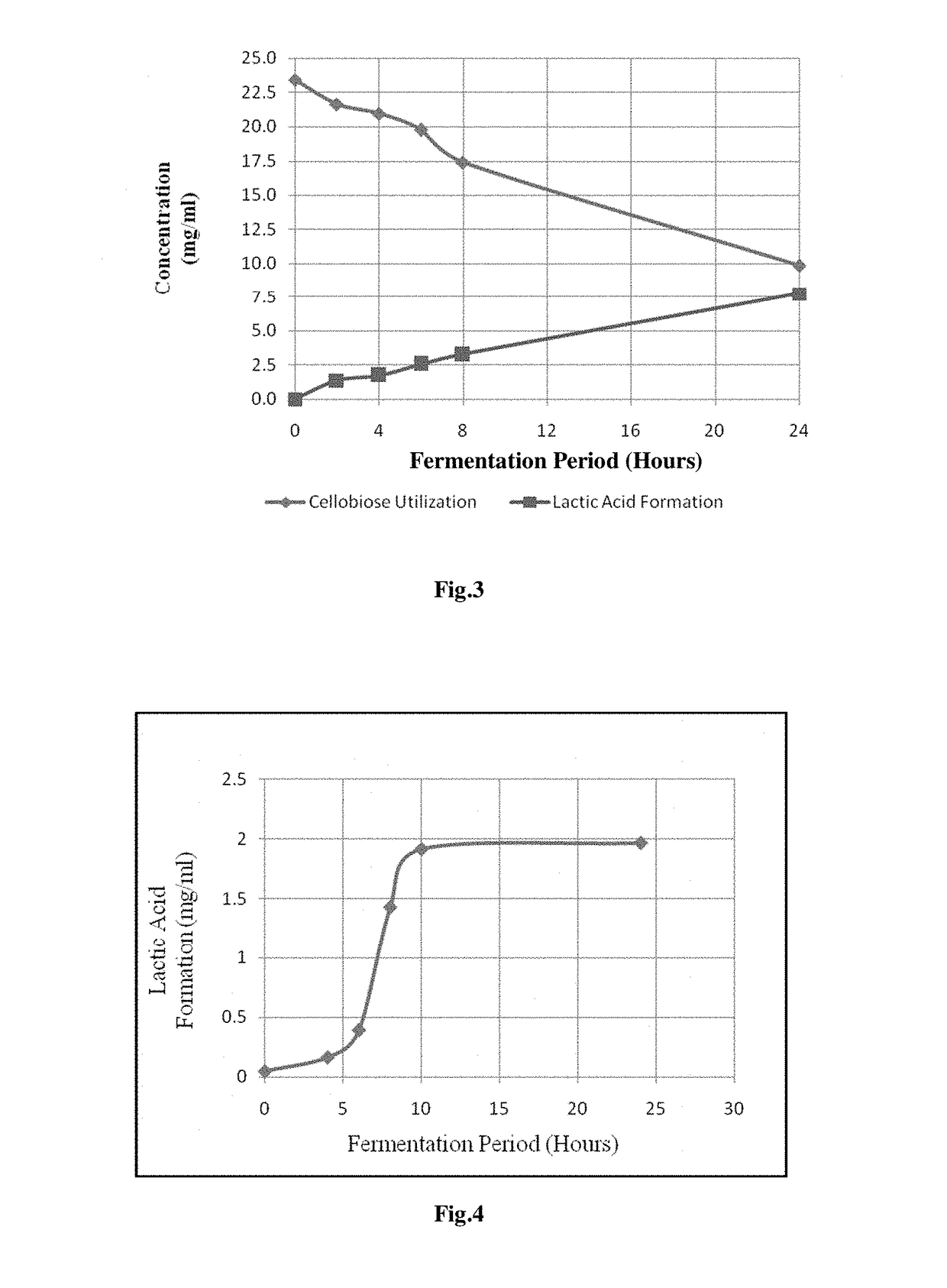Method of consolidated bioprocessing of lignocellulosic biomass for production of L-lactic acid
a technology of lignocellulosic biomass and consolidated bioprocessing, which is applied in the field of consolidated bioprocessing of lignocellulosic biomass to llactic acid, can solve the problems of lactic acid fermentation, failure to report the lactic acid production of the isolated strain, and inability to meet the optimal conditions, etc., and achieves simple efficiency
- Summary
- Abstract
- Description
- Claims
- Application Information
AI Technical Summary
Benefits of technology
Problems solved by technology
Method used
Image
Examples
example 1
n of L-Lactic Acid Using Glucose as Sole Carbon Source
[0064]Seed cultures of Paenibacillus macerans IIPSP3 (MTCC 5569) were grown aerobically at 50° C. in 100 ml Erlenmeyer Flask containing 20 ml medium with following composition (Table 1). Before inoculation of Paenibacillus macerans IIPSP3 (MTCC 5569), the said media was autoclaved at 121° C. for 15 min, with final pH value of 7.2±0.3. The carbon source in the said medium in this experiment was glucose.
[0065]
TABLE 1Medium Composition for growth of Paenibacillus maceransIIPSP3 (MTCC 5569) and fermentationg / LMedia ComponentsCarbon Source20Yeast Extract2(NH4)2SO42KH2PO40.26Na2HPO4•7H2O2.17MgCl2•6H2O0.2CaCl2 (Fused)0.025Trace Metal Solution2 ml / LComposition of Trace Metal SolutionNa2EDTA0.4MnS04•4H2O0.34(NH4)6 Mo7O24•4H2O0.4FeSO4•7H2O0.8CoCl2•6H2O0.04NiCl2•6H2O0.02ZnSO4•7H2O0.02
[0066]2 ml of Mid-log aliquot of seed culture was transferred to 100 ml of autoclaved fermentation medium placed in 500 ml capacity Erlenmeyer flask, with gluc...
example 2
ion of End Product as L (+) Lactic Acid by NMR Studies
[0070]Lactic acid, as a fermentation product, was confirmed via 1D 1H-NMR and 1D 13C-NMR spectroscopy. Bruker Avance III 500 MHz spectrometer equipped with 5 nm BBO probe head, operating at 125.77 MHz and 50.13 MHz resonance frequency was used for obtaining 13C and 1H NMR spectra respectively. The conventional 13C NMR was carried out by reverse gated coupling mode using following parameters: NS=492, D1-5 sec. After neutralization of the fermentation broth with CaCO3 L-Lactic acid existed in Calcium L-Lactate form in the broth, thus a 20% (w / v) solution of Calcium L-Lactate Hydrate in D2O was used for reference purpose.
[0071]The 13 C spectra of reference sample (pure calcium lactate) showed 3 peaks at 19.9 ppm, 68.3 ppm, 182.4 ppm which correspond to carbons present in functional groups —CH3, —CH—OH, —COO— respectively. The NMR spectra of fermentation broth sample also showed 3 major peaks at 20.15 ppm, 68.6 ppm, 182.5 ppm. A perf...
example 3
Neutralizing Agent on L-Lactic Acid Production Using Glucose as Sole Source of Carbon
[0072]All the experimental conditions for the seed culture, production and analysis of end products were identical as mentioned in Example 1, except for the incubation time and use of neutralizing agent. Two different neutralizing agents were used to control pH of the medium, one being 5% sterile NaOH and other being 5% sterile Ca(OH)2.
[0073]The present experiment was restricted to 24 hours only and the L-lactic acid formation is shown in Table 3.
[0074]
TABLE 3Effect of neutralizing agent on the productivity of L-Lactic Acid by Paenibacillus macerans IIPSP3 (MTCC 5569) fed with 2% glucose as carbon source.Hours ofResidual Glucose (mg / ml) L(+)-lactic acid formed (mg / ml)IncubationFlask A Flask BFlask CFlask AFlask BFlask C021.5821.5821.58000419.4218.4618.712.232.231.742417.8213.2311.923.468.146.88Note:Flask A-No pH control;Flask B-pH control with 5% NaOH,Flask C-pH control with 5% Ca(OH)2
[0075]As evide...
PUM
| Property | Measurement | Unit |
|---|---|---|
| temperature | aaaaa | aaaaa |
| temperature | aaaaa | aaaaa |
| temperature | aaaaa | aaaaa |
Abstract
Description
Claims
Application Information
 Login to View More
Login to View More - R&D
- Intellectual Property
- Life Sciences
- Materials
- Tech Scout
- Unparalleled Data Quality
- Higher Quality Content
- 60% Fewer Hallucinations
Browse by: Latest US Patents, China's latest patents, Technical Efficacy Thesaurus, Application Domain, Technology Topic, Popular Technical Reports.
© 2025 PatSnap. All rights reserved.Legal|Privacy policy|Modern Slavery Act Transparency Statement|Sitemap|About US| Contact US: help@patsnap.com


